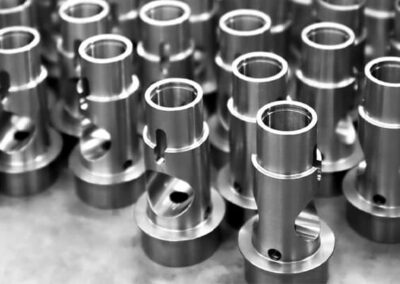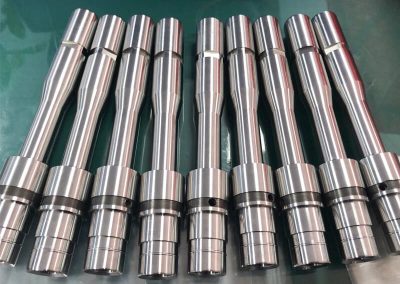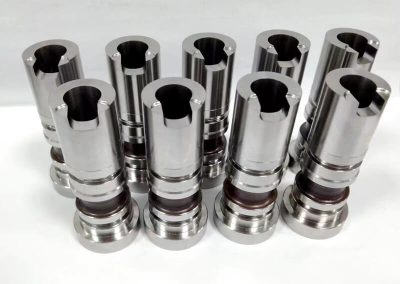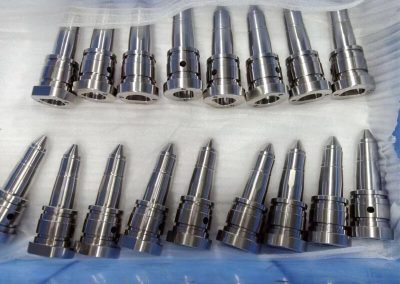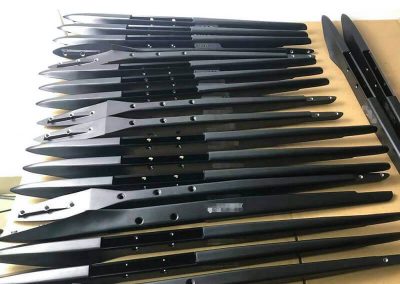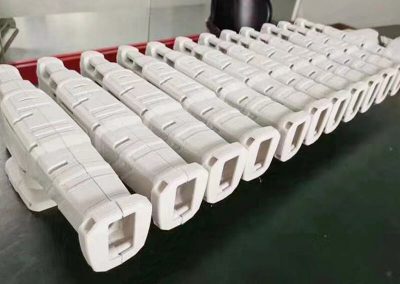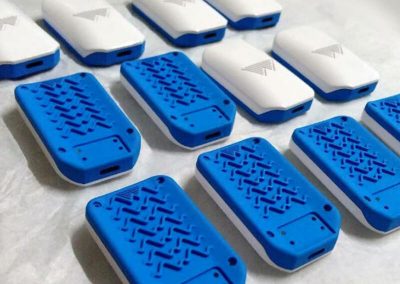Guide of High Volume Machining
Get reduced costs, quick-turn lead times, and finishing options from a single-source supplier
High volume machining refers to the manufacturing process of producing a large quantity of parts or components with consistent quality and precision within a relatively short time frame. High volume machining involves the utilization of advanced machinery, tools, and automation techniques to achieve efficient and cost-effective production at scale.
High volume machining is used for efficiently manufacturing a great deal of custom parts or components with high quality. Machining also works well for jigs, tools, fixtures, and other low-volume parts, and allows flexibility and affordability with part production. This guide covers our higher-volume machining capabilities, finishing options, and more.
Benefits of High Volume Machining:
- Cost-effectiveness
- Consistent quality
- Faster production cycles
- Flexibility and customization
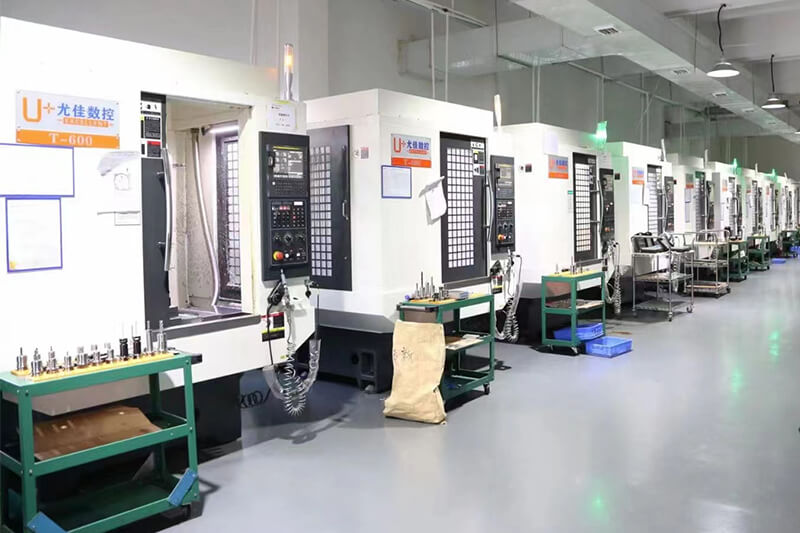
Our High Volume Machining Services
High-volume machining covers a range of processes including precision milling, turning, drilling, grinding and more. These processes involve removing material from workpieces to obtain the desired shape, size and surface finish. These high-volume machining processes are combined with advanced CNC technology to efficiently and accurately produce high-volume parts.
- Precision Milling: 3-axis, 4-axis, 5-axis CNC machining. Our CNC precision machining accuracy can reach +/- 0.01mm.
- Turning: Turning is used to machine cylindrical workpieces and can perform finishing operations such as facing, chamfering or grooving to achieve the desired surface finish and dimensional accuracy. Our turning accuracy can reach +/- 0.02mm.
- Drilling: Drilling is the process of drilling a hole in a workpiece using a rotary drill. Our drilling accuracy can reach +/- 0.02mm.
- Grinding: Grinding processes can be used to achieve precise dimensions, tight tolerances and excellent surface finish, for example for precision mold inserts. Our precision grinding machines have a machining accuracy of up to +/- 0.002mm.
What High Volume Machining Equipments Do We Offer?
In high volume machining, a variety of machinery and equipment include CNC machining centers, lathes, milling machines, grinding machines, and specialized tools such as drills, cutters, and inserts. These machines are equipped with advanced features like multiple axes, automatic tool changers, and high-speed spindles to optimize productivity and precision.
Each machine and tool is selected based on the specific requirements of the part, desired production volume, and the capabilities of the machining facility. The continuous advancements in machining technology contribute to increased productivity, precision, and efficiency in high volume manufacturing processes.
CNC Machining Centers: They are equipped with multiple axes (typically 3 to 5 axes) and can move the cutting tool in different directions simultaneously. CNC machining centers can perform milling, drilling, tapping, and sometimes turning operations in a single setup, making them highly efficient for high volume production.
CNC Lathes: Designed specifically for turning operations. They rotate the workpiece while a cutting tool removes material to create cylindrical shapes. CNC lathes often have multiple axes, allowing for complex machining operations, such as turning, facing, threading, and grooving. They can be used to produce high volumes of precision parts with excellent surface finishes.
CNC Milling Machines: Used for precision milling operations. They have a rotating cutting tool that removes material from the workpiece to create various features, such as slots, pockets, contours, and complex 3D shapes. CNC milling machines can be equipped with horizontal or vertical spindles and may have multiple axes to enable simultaneous cutting in multiple directions.
Grinding Machines: Used to achieve fine surface finishes and precise dimensions through abrasive material removal. They utilize grinding wheels or abrasive belts to remove material from the workpiece. Different types of grinding machines, such as surface grinders, cylindrical grinders, and centerless grinders, are used depending on the specific requirements of the part.
Drilling Machines: Used to create holes in the workpiece. They employ rotating drill bits to remove material and generate holes of various diameters and depths. CNC drilling machines can automate the drilling process, allowing for precise hole placement and consistent results.
Cutting Tools and Inserts: A variety of cutting tools and inserts include end mills, drills, taps, reamers, inserts, and more. Cutting tools and inserts are selected based on factors such as the material being machined, required surface finish, and specific machining operation. They are designed to provide high cutting speeds, long tool life, and efficient chip evacuation.
Measurement and Inspection Equipment: High volume machining often involves the use of measurement and inspection equipment to ensure dimensional accuracy and quality control. This may include calipers, micrometers, height gauges, coordinate measuring machines (CMMs), and vision systems. These tools are used to verify part dimensions, tolerances, and surface finishes.
Materials Machined in High Volume Machining
Metals
- Steel: Carbon steel, stainless steel, tool steel, alloy steel.
- Aluminum: Aluminum alloys, such as 6061, 7075, and 2024.
- Brass: Commonly used in electrical and plumbing applications.
- Copper: Often utilized in electrical components and heat exchangers.
- Titanium: Known for its high strength-to-weight ratio and corrosion resistance.
- Nickel alloys: Inconel, Hastelloy, Monel, and other heat-resistant alloys.
- Cast iron: Used in applications requiring high wear resistance and stability.
Plastics
- Polyethylene (PE): Low-density and high-density variations.
- Polypropylene (PP): Lightweight and chemical-resistant.
- Acrylonitrile Butadiene Styrene (ABS): Durable and impact-resistant.
- Polycarbonate (PC): Transparent, strong, and heat-resistant.
- Polyethylene terephthalate (PET): Commonly used for packaging materials.
- Polyurethane (PU): Versatile material with excellent elasticity and durability.
Composites
- Carbon fiber reinforced polymers (CFRP): Lightweight and high-strength.
- Glass fiber reinforced polymers (GFRP): Good strength-to-weight ratio.
- Aramid fiber reinforced polymers (AFRP): High impact resistance and durability.
- Ceramic matrix composites (CMC): Excellent thermal and chemical resistance.
Samples of High Volume Machining
Automotive Industry
- Engine components: Cylinder heads, engine blocks, pistons, crankshafts.
- Transmission components: Gears, shafts, housings.
- Suspension and steering components: Control arms, knuckles, steering columns.
- Brake system components: Calipers, rotors, drums.
Aerospace Industry
- Aircraft components: Structural parts, wing spars, landing gear components, engine mounts.
- Turbine components: Blades, vanes, casings.
- Avionics and instrument components: Housings, brackets, connectors.
Electronics Industry
- Printed Circuit Board (PCB) components: Heat sinks, connectors, housings.
- Semiconductor components: Heat spreaders, lead frames, packages.
- Enclosures and chassis for electronic devices.
Medical Industry
- Surgical and orthopedic implants: Hip/knee replacements, spinal implants.
- Medical device components: Surgical tools, prosthetics, dental implants.
- Diagnostic equipment components: X-ray and MRI machine parts, robotic arms.
Industrial Equipment
- Pump and valve components: Housings, impellers, valve bodies.
- Heavy machinery components: Gearboxes, hydraulic cylinders, bearing housings.
- Power generation components: Turbine blades, generator parts, heat exchangers.
Consumer Goods
- Appliances: Housings, brackets, internal components.
- Furniture: Metal or plastic components for chairs, tables, and cabinets.
- Sporting goods: Bicycle frames, golf club heads, firearm components.
Energy and Renewable Energy
- Oil and gas industry components: Drill bits, valves, connectors.
- Wind turbine components: Gearboxes, rotor blades, tower sections.
- Solar panel components: Frames, brackets, mounting systems.
These are just a few examples of the wide range of applications where high volume machining is utilized. The ability to produce custom parts in large quantities with precision, efficiency, and cost-effectiveness makes high volume machining valuable across various industries.
Custom Parts Production Solutions – Sungplastic
Sunplastic will utilize more than 20 years of processing and manufacturing experience to provide the best one-stop machining solution for specific industries and customer needs.
Partnerships with clients
Close collaboration ensures we fully understand our customers’ requirements, design intent and performance expectations. Regular communication, feedback loops and joint problem solving enable Sung Plastic to provide custom solutions that meet or exceed your expectations.
Design for Manufacturability (DFM) Considerations
Design for Manufacturability (DFM) principles are critical to custom part production. DFM involves considering manufacturing processes, capabilities, and constraints when designing a part. DFM considerations include material selection, design simplification, tolerance optimization, and assembly feasibility.
Collaboration between Sung Plastic’s design and manufacturing teams ensures parts are optimized for efficient production, minimizing manufacturing challenges and reducing costs.
Prototyping and rapid manufacturing
Prototyping plays a vital role in custom part production solutions. It allows validation of design concepts, functional testing and identification of potential issues early in the process. Prototypes can be iteratively refined, incorporating feedback and making necessary modifications to improve performance, manufacturability, and overall quality. Rapid prototyping techniques such as 3D printing facilitate fast turnaround times and cost-effective iterations.
On Demand Manufacturing
Sungplastic will ensure that the production process can be scaled up or down to meet changing demands. This requires flexible manufacturing systems, adaptable production lines and agile scheduling. Modular tools, standardized processes and versatile machine setups allow for fast changeovers, efficient use of resources and the ability to adapt to varying production volumes and product changes.
By implementing effective custom parts production solutions, Sungplastic can meet specific application requirements, provide high-quality components, and maintain a competitive edge in the market. Sungplastic will provide you with professional high-volume processing services, including multiple material options, manufacturing techniques, and competitive cost and quality advantages. We also utilize a range of advanced machinery and skilled technicians with extensive production experience to assist with your important projects.
If you are interested in high-volume processing, please contact us today!
Get a free quote and design analysis today.
We’ll reply to you within 6 working hours.
We respect your privacy.
+86 139 2927 4777 (WhatsApp, Wechat)

